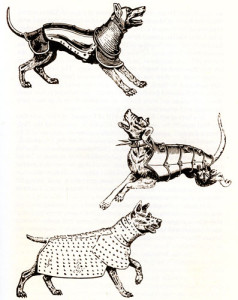I found it interesting in the interview we listened to in class as well as wondering myself where the title of Helena Maria Viramonte’s book came from. I started with the epigraph at the beginning of the book:
“They came in battle array, as conquerors, and the dust rose in whirlwinds not the roads. Their spears glinted in the sun, and their pennons fluttered like bats. They made a loud
clamor as they marched, for their coats of mail and their weapons clashed and rattled. Some of them were dressed in glistening iron from head to foot; they terrified everyone who saw them. Their dogs came with them, running ahead of the column. They raised their muzzles high; they lifted their muzzles to the wind. They raced on before with saliva dripping from their jaws” (Viramonte).
This is a quote from Miguel Leon-Portilla’s book, The Broken Spears: The Aztec Account of the Conquest of Mexico. Already we know that it is an account of the ancient Aztecs point of view when the Spanish Conquistadors conquered by the expansive Empire in 1519-1521. The Spanish were led by Hernando Cortez and Native American allies and prevailed over the Aztecs through diplomacy and ferocious combat in the Aztec capital, Tenochtitlan. The Spanish housed an army of 400 Spanish soldiers, 15 horses, 1,300 Indian warriors, artillery, and a thousand porters who also brought along many dogs that had been trained to fight in combat.
In Their Dogs Came with Them, Viramonte takes this knowledge and employs it as a comparison between the past usage of dogs conquering people to the present day 1960s containment and killing of dogs. Viramonte’s novel is centered around the construction of freeways in East Los Angeles as well as the quarantine of a rabies outbreak. Four women are the main focus and dogs are prevalent throughout their lives as the city has enforced a curfew at night. With the backdrop of the violence and brutality of the Spanish and Aztec battle, Viramonte places lots of war motifs throughout the intertwining lives of the women and the current cultural situation. As a result of this, Viramontes “invites readers to draw connections between the Aztecs under siege and the experiences of poor and working-class Chicanas/os displaced by the increased urbanization of East LA” (Cuevas). Cuevas is a Chicano writer and made an interesting observation about the novel:
“The fictional events allude to times when Chicano neighborhoods have experienced especially violent policing of their everyday movements, such as during the 1940s Zoot Suit Riots, the school walkouts during the 1968 Chicano Blowouts, and the 1970 Chicano Moratorium. By drawing on this history, Viramontes represents Chicanos as an internally colonized people and explores how marginalized groups negotiate their desire to decolonize their own minds and lives” (Cuevas).
Viramontes was even quoted using war words to describe her novel including saying that the addition of the freeways “amputated” East Los Angeles and the women, as well as created a location of the “bones of the forgotten” (KCRW Interview).
Works Cited:
Cuevas, T Jackie. “T. Jackie Cuevas on ‘Their Dogs Came with Them’”. E3W Review of Books. 2008. Web. 12 April 2014. <http://www.dwrl.utexas.edu/orgs/e3w/volume-8-spring-2008/¿estamos-post-borderlands-o-no/t-jackie-cuevas-on-their-dogs-came-with-them>
Viramontes, Helena Maria. Their Dogs Came with Them. New York: Washington Square Press, 2007. Print.
KCRW Interview: http://www.kcrw.com/etc/programs/bw/bw070816helena_maria_viramon
Pictures:
https://ewaldvanvugt.wordpress.com/2010/10/
http://www.mexicolore.co.uk/aztecs/home/vicious-dogs



I think that this blog post is thoughtful and your interpretation of the presence of dogs is both apt and surprising. I did not know about the roles of dogs in Aztec culture and I think that the parallels between the Spanish colonization of Mexico and the displacement of Chicana/os is a familiar pattern we see when a conquering or domination group displace an indigenous one. I feel that the rabid dog story line is symbolic of wanting to rid “undesirable” elements for the benefit of the ruling class. The freeway construction of the late 1940’s didn’t take place in Beverly Hills or Malibu, for example. The area was already a place where minorities were forced to live because of real estate restrictions during that time. The disruption of community if reflected in the relationships of the women in the book-they are tangentially connected, but that connection is as tenuous as the the existence of their neighborhoods. I think Turtle best exemplifies this position: she is in between identities, but fits nowhere. She yearns for her brother’s love and respect, but can’t earn it. She is hungry and desperate and her lack of sense of belonging reflects the neighborhood’s sense of displacement, too.